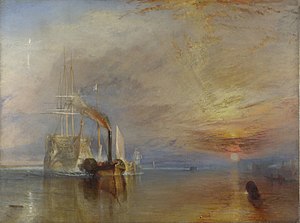
| |
| History | |
|---|---|
| Name | HMS Temeraire |
| Ordered | 9 December 1790 |
| Builder | Chatham Dockyard |
| Laid down | July 1793 |
| Launched | 11 September 1798 |
| Reclassified |
|
| Fate | Broken up in 1838 |
| General characteristics [1] | |
| Class and type | Neptune-class ship of the line |
| Tons burthen | 2,12058⁄94 (bm) |
| Length |
|
| Beam | 51 ft 2 in (15.60 m) |
| Depth of hold | 21 ft 6 in (6.55 m) |
| Sail plan | Full-rigged ship |
| Complement | 738 |
| Armament |
|
HMS Temeraire was a 98-gun second-rate ship of the line of the United Kingdom's Royal Navy. Launched in 1798, she served during the French Revolutionary and Napoleonic Wars, mostly on blockades or convoy escort duties. She fought only one fleet action, the Battle of Trafalgar, but became so well known for that action and her subsequent depictions in art and literature that she has been remembered as The Fighting Temeraire.
Built at Chatham Dockyard, Temeraire entered naval service on the Brest blockade with the Channel Fleet. Missions were tedious and seldom relieved by any action with the French fleet. The first incident of note came when several of her crew, hearing rumours they were to be sent to the West Indies at a time when peace with France seemed imminent, refused to obey orders. This act of mutiny eventually failed and a number of those responsible were tried and executed. Laid up during the Peace of Amiens, Temeraire returned to active service with the resumption of the wars with France, again serving with the Channel Fleet, and joined Horatio Nelson's blockade of the Franco-Spanish fleet in Cadiz in 1805. At the Battle of Trafalgar on 21 October, the ship went into action immediately astern of Nelson's flagship, HMS Victory. During the battle Temeraire came to the rescue of the beleaguered Victory, and fought and captured two French ships, winning public renown in Britain.
After undergoing substantial repairs, Temeraire was employed blockading the French fleets and supporting British operations off the Spanish coasts. She went out to the Baltic in 1809, defending convoys against Danish gunboat attacks, and by 1810 was off the Spanish coast again, helping to defend Cadiz against a French army. Her last action was against the French off Toulon, when she came under fire from shore batteries. The ship returned to Britain in 1813 for repairs, but was laid up. She was converted to a prison ship and moored in the River Tamar until 1819. Further service brought her to Sheerness as a receiving ship, then a victualling depot, and finally a guard ship. The Admiralty ordered her to be sold in 1838, and she was towed up the Thames to be broken up.
This final voyage was depicted in a J. M. W. Turner oil painting greeted with critical acclaim, entitled The Fighting Temeraire tugged to her last Berth to be broken up, 1838.[2] The painting continues to be held in high regard: it was voted Britain's favourite painting in a BBC radio poll in 2005[3] and it appears briefly in the James Bond movie Skyfall.[4] A reproduction of the painting appears on the back of the Bank of England £20 note issued in 2020.
- ^ Winfield. British Warships in the Age of Sail 1793–1817. pp. 25–6.
- ^ "The Story Behind The Fighting Temeraire | ArtGallery.co.uk". artgallery.co.uk. Retrieved 11 September 2020.
- ^ "BBC - Press Office - The Fighting Temeraire voted the Greatest Painting in Britain". www.bbc.co.uk. Retrieved 11 September 2020.
- ^ Fandino, Daniel (14 May 2019). "Skyfall: The Fighting Temeraire". Journey to the (Wired) West. Retrieved 11 September 2020.